What is bacterial vaginosis (BV)?
The vagina normally contains many different types of bacteria. Some of these bacteria are ‘friendly’ but others are potentially harmful – there is a delicate balance between the two types. The healthy vagina is slightly acidic (pH 3.8–4.5) and these acid levels keep the harmful bacteria under control.
Bacterial vaginosis (also known as BV) is a condition that arises when there is an imbalance between these types of bacteria and an overgrowth of the harmful bacteria associated with an increase in pH as the vagina becomes less acidic. BV is the most common cause of vaginal discharge and affects up to 1 in 3 women, including up to 20% of pregnant women*.
How will I know if I have bacterial vaginosis (BV)?
BV typically causes a watery, grey-white vaginal discharge that has an unpleasant (fishy) smell. Many women with BV mistakenly think they have a yeast infection and use treatments for yeast infection, which will not help with BV.
Yeast infections are fungal infections that also cause a white vaginal discharge that is not malodorous; yeast infections also usually cause itching. Ask your pharmacist for advice on which treatments are most suitable for you. If you have a yellow, green, or brownish discharge, vaginal bleeding, or pain, you should speak to your doctor or visit a gynecologist. If you are pregnant, speak to your doctor or gynecologist.
What causes bacterial vaginosis (BV)?
The cause of BV is still something of a mystery but it is not a sexually transmitted infection and is not caused by poor personal hygiene. BV may be made worse by some things, such as bubble baths, regular shower gels, or douching. It is thought these may alter the acid levels in the vagina and upset the balance between the friendly and harmful bacteria, so avoiding these might help.
How is bacterial vaginosis (BV) treated?
BV is often treated with antibiotic tablets, gels, or creams. However, in many women BV is a recurrent condition despite treatment.



